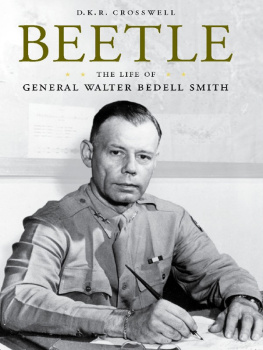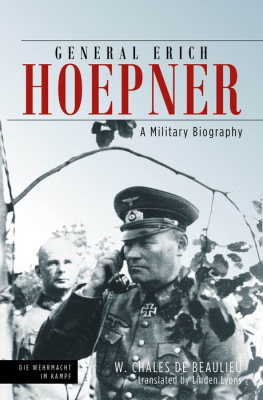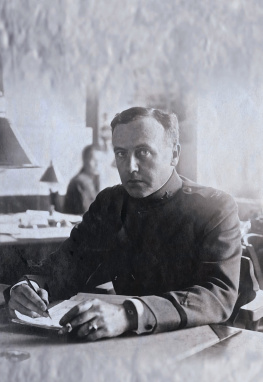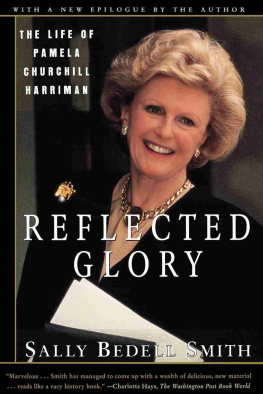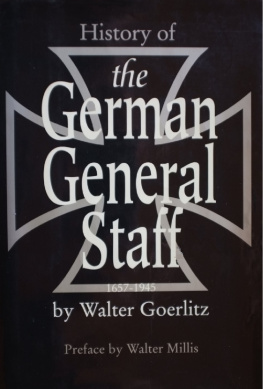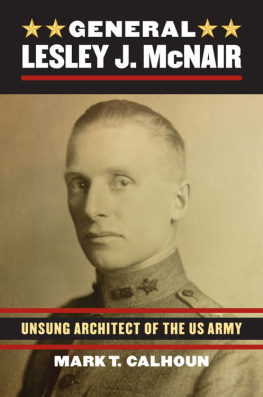American Warriors
Throughout the nations history, numerous men and women of all ranks and branches of the United States military have served their country with honor and distinction. During times of war and peace, there are individuals whose exemplary achievements embody the highest standards of the U.S. armed forces. The aim of the American Warriors series is to examine the unique historical contributions of these individuals, whose legacies serve as enduring examples for soldiers and citizens alike. The series will promote a deeper and more comprehensive understanding of the U.S. armed forces.
Series editor: Roger Cirillo

An AUSA Book
BEETLE

The Life of
General Walter Bedell Smith
D. K. R. CROSSWELL

Copyright 2010 by The University Press of Kentucky
Scholarly publisher for the Commonwealth,
serving Bellarmine University, Berea College, Centre College of Kentucky, Eastern Kentucky University, The Filson Historical Society, Georgetown College, Kentucky Historical Society, Kentucky State University, Morehead State University, Murray State University, Northern Kentucky University, Transylvania University, University of Kentucky, University of Louisville, and Western Kentucky University. All rights reserved.
Editorial and Sales Offices: The University Press of Kentucky
663 South Limestone Street, Lexington, Kentucky 405084008
www.kentuckypress.com
Maps from Thomas Greiss, ed., West Point Atlas for the Second World War: Europe and the Mediterranean, www.military.com/Resources . Photographs courtesy of the Dwight D. Eisenhower Library.
14 13 12 11 10 5 4 3 2 1
Library of Congress Cataloging-in-Publication Data
Crosswell, D. K. R. (Daniel K. R.)
Beetle: the life of general Walter Bedell Smith / D. K. R. Crosswell.
p. cm. (American warriors)
Includes bibliographical references and index.
ISBN 978-0-8131-2649-4 (hardcover: alk. paper)
1. Smith, Walter Bedell, 18951961. 2. GeneralsUnited StatesBiography. 3. United States. ArmyBiography. 4. StatesmenUnited StatesBiography. 5. United StatesHistory, Military20th century. I. Title.
E745.S57C75 2010
355.0092dc22
[B] 2010026300
This book is printed on acid-free recycled paper meeting the requirements of the American National Standard for Permanence in Paper for Printed Library Materials.

Manufactured in the United States of America.

To my parents:
by birthEarl Edward and Kathleen Crosswell;
and by choiceWillard James and Betty Marie Kaylor
Contents
IIlustrations
Acknowledgments
This project began in an odd way. Henry Gerard Red Phillips, author of The Making of a Professional: Manton S. Eddy, suggested to Roger Cirillo, director of the Association of the United States Army (AUSA) book program, that my first book be released in paperback. When Cirillo approached me with the idea, I asked whether we should consider a new book on Smith. The notion of the same author writing a second biography of Smith struck me as a little unconventional, but Roger ran with it. Without these two colonels, this book would never have been written; I owe them both a huge debt of gratitude.
Research for the book took place in stages. I owe the late Merle Miller a great deal. Unbeknownst to Miller, he funded the lions share of the research for the first Smith book. Stung by the controversy emerging out of the publication of Plain Speaking: An Oral History of Harry S. Truman, Miller wanted his biography of Eisenhower to be fully documented and employed me as his lead researcher. Miller provided ample funding that allowed me to amass sources from the Dwight David Eisenhower Presidential Library, the Command and General Staff College, the War College, the Manuscript Division of the National Archives, the Library of Congress, and a number of British depositories. A two-year stint at James Madison University allowed me to build on this foundation, given the proximity to Washington, to Carlisle, Pennsylvania, and to the George C. Marshall Library in Lexington, Virginia. My exile to Singapore in 1990 imposed impediments, but I still managed research forays back to Washington, Carlisle, and Abilene and Leavenworth, Kansas. If I date this project back to Miller, it has been in the works for twenty-eight years and has outlived many of the people who lent invaluable assistance along the way: Forrest Pogue via letters; Russell Vitrup and Carter Burgess via interviews; Larry Bland of the Marshall Library, who was enormously helpful as I charted my way through the vertical filecard collection Pogue compiled for Supreme Command; and Judge Leon LeSueur of Napoleonville, Louisiana, a veteran of Normandy who read and commented on my first book. I extend my gratitude to the many archivists who aided me over the years, especially David Haight and Tom Branigar, now both retired from the Eisenhower Library, and David Keough of the U.S. Army Military History Institute. Similarly, I thank the staffs of the Indiana State Library, Indianapolis; Watson Library, University of Kansas; Hale Library, Kansas State University; Central Library, National University of Singapore; Singapore Armed Forces Military Institute library; and Willard Library, Battle Creek, Michigan.
Roger Cirillo has been the driving force behind this project from its inception. The funny thing is, twice I traveled to Washington, in part to meet and thank Roger, but both times he mysteriously went AWOL, making me wonder if he actually existed. He does, as his many emails testify. Roger ran interference, provided moral support and good cheer, and shared his amazing command of sources and the knowledge derived not only from his academic background as a historian, educator, and editor but also from his wide experience as a staff officer. Roger subtly weaned me away from my biases and added enormously to my understanding of the way things work in a headquarters or on the ground. Simply put, this project never would have happened without Roger, and I cannot begin to thank him enough; perhaps someday I might get the chance to do so in person.
Many other people have rendered invaluable assistance along the way, including Richard Grismore of Emmerich Manual High School and Sondrea Ozolins of Butler University, both in Indianapolis, who filled in the gaps in Smiths educational record; Lynsey Robertson of the Churchill Archives Centre and Lianne Smith of the Liddell Hart Centre for Military Archives, who provided amazingly prompt responses to my queries; and particularly MG David T. Zabecki AUS (Ret.), who read and critiqued the manuscript. Overdue thanks to Dominick Toby GrahamMilitary Cross recipient, Olympian, and professor at the University of New Brunswickwho made a trip to the depths of southwestern Missouri to visit and counsel a struggling young academic. I am constantly reminded of the debt owed to the members of my dissertation committee: Emeritus Professor Robin Higham and Professor Donald Mrozek of Kansas State University and Jake Kipp, deputy director of the U.S. Army School of Advanced Military Studies and director of the Foreign Military Studies Office, Fort Leavenworth, Kansas. The late George Krens healthy skepticism of the workings of the world has always served me as a guide.
Next page
